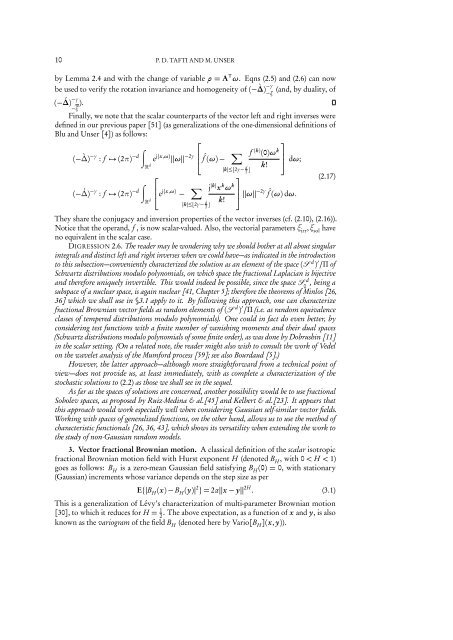FRACTIONAL BROWNIAN VECTOR FIELDS 1. Introduction. A one ...
FRACTIONAL BROWNIAN VECTOR FIELDS 1. Introduction. A one ...
FRACTIONAL BROWNIAN VECTOR FIELDS 1. Introduction. A one ...
Create successful ePaper yourself
Turn your PDF publications into a flip-book with our unique Google optimized e-Paper software.
10 P. D. TAFTI AND M. UNSER<br />
by Lemma 2.4 and with the change of variable ρ = A T ω. Eqns (2.5) and (2.6) can now<br />
−γ<br />
be used to verify the rotation invariance and homogeneity of (− `∆) (and, by duality, of<br />
−ξ<br />
−γ<br />
(− ´∆) ).<br />
−ξ<br />
Finally, we note that the scalar counterparts of the vector left and right inverses were<br />
defined in our previous paper [51] (as generalizations of the <strong>one</strong>-dimensional definitions of<br />
Blu and Unser [4]) as follows:<br />
⎡<br />
⎤<br />
∫<br />
(− `∆) −γ : f → (2π) −d e j〈x,ω〉 ‖ω‖ −2γ ⎢<br />
⎣ ˆf (ω) −<br />
∑ f (k) (0)ω k<br />
⎥<br />
d k! ⎦ dω;<br />
|k|≤⌊2γ− d 2 ⌋<br />
⎡<br />
⎤<br />
(2.17)<br />
∫<br />
(− ´∆) −γ : f → (2π) −d ⎢<br />
⎣ ej〈x,ω〉 −<br />
∑ j |k| x k ω k<br />
⎥<br />
d k! ⎦ ‖ω‖−2γ ˆf (ω) dω.<br />
|k|≤⌊2γ− d 2 ⌋<br />
They share the conjugacy and inversion properties of the vector inverses (cf. (2.10), (2.16)).<br />
Notice that the operand, f , is now scalar-valued. Also, the vectorial parameters ξ irr ,ξ sol have<br />
no equivalent in the scalar case.<br />
DIGRESSION 2.6. The reader may be wondering why we should bother at all about singular<br />
integrals and distinct left and right inverses when we could have—as indicated in the introduction<br />
to this subsection—conveniently characterized the solution as an element of the space ( d ) ′ /Π of<br />
Schwartz distributions modulo polynomials, on which space the fractional Laplacian is bijective<br />
and therefore uniquely invertible. This would indeed be possible, since the space d , being a<br />
0<br />
subspace of a nuclear space, is again nuclear [41, Chapter 5]; therefore the theorems of Minlos [26,<br />
36] which we shall use in §3.1 apply to it. By following this approach, <strong>one</strong> can characterize<br />
fractional Brownian vector fields as random elements of ( d ) ′ /Π (i.e. as random equivalence<br />
classes of tempered distributions modulo polynomials). One could in fact do even better, by<br />
considering test functions with a finite number of vanishing moments and their dual spaces<br />
(Schwartz distributions modulo polynomials of some finite order), as was d<strong>one</strong> by Dobrushin [11]<br />
in the scalar setting. (On a related note, the reader might also wish to consult the work of Vedel<br />
on the wavelet analysis of the Mumford process [59]; see also Bourdaud [5].)<br />
However, the latter approach—although more straightforward from a technical point of<br />
view—does not provide us, at least immediately, with as complete a characterization of the<br />
stochastic solutions to (2.2) as those we shall see in the sequel.<br />
As far as the spaces of solutions are concerned, another possibility would be to use fractional<br />
Sobolev spaces, as proposed by Ruiz-Medina & al.[45] and Kelbert & al.[23]. It appears that<br />
this approach would work especially well when considering Gaussian self-similar vector fields.<br />
Working with spaces of generalized functions, on the other hand, allows us to use the method of<br />
characteristic functionals [26, 36, 43], which shows its versatility when extending the work to<br />
the study of non-Gaussian random models.<br />
3. Vector fractional Brownian motion. A classical definition of the scalar isotropic<br />
fractional Brownian motion field with Hurst exp<strong>one</strong>nt H (denoted B H , with 0 < H < 1)<br />
goes as follows: B H is a zero-mean Gaussian field satisfying B H (0) = 0, with stationary<br />
(Gaussian) increments whose variance depends on the step size as per<br />
E{|B H (x) − B H (y)| 2 } = 2α‖x − y‖ 2H . (3.1)<br />
This is a generalization of Lévy’s characterization of multi-parameter Brownian motion<br />
[30], to which it reduces for H = 1 . The above expectation, as a function of x and y, is also<br />
2<br />
known as the variogram of the field B H (denoted here by Vario[B H ](x, y)).
















